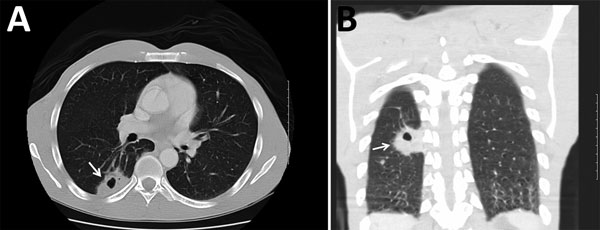Volume 24, Number 11—November 2018
CME ACTIVITY - Synopsis
Cryptococcus gattii Complex Infections in HIV-Infected Patients, Southeastern United States
Figure

Figure. Computed tomography images of the chest of an HIV-infected 47-year-old man (case-patient 3) with Cryptococcus gattii complex infection, southeastern United States. Transverse (A) and frontal (B) views without intravenous contrast showed a mass (arrows) (4.0 cm × 2.5 cm) that had central cavitation posteriorly in the right lower lobe abutting the pleural surface. The central cavitary portion of this lesion had a maximum length of ≈1.3 cm and no evidence of fluid level or internal soft tissues
1Current affiliation: Archbold Medical Center, Thomasville, Georgia, USA.
Page created: October 15, 2018
Page updated: October 15, 2018
Page reviewed: October 15, 2018
The conclusions, findings, and opinions expressed by authors contributing to this journal do not necessarily reflect the official position of the U.S. Department of Health and Human Services, the Public Health Service, the Centers for Disease Control and Prevention, or the authors' affiliated institutions. Use of trade names is for identification only and does not imply endorsement by any of the groups named above.